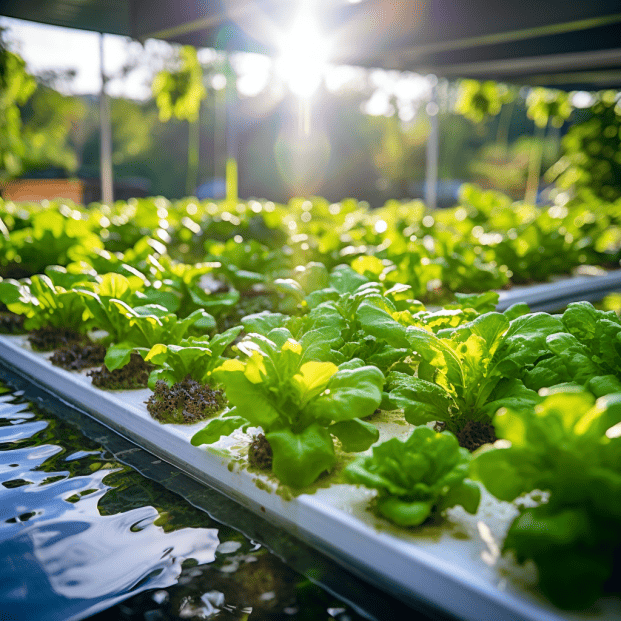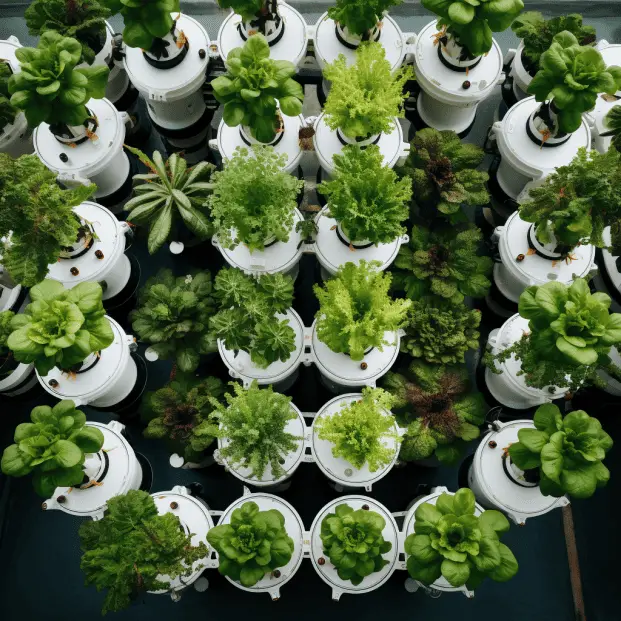Understanding hydroponic nutrition is crucial for any grower looking to unlock their plant’s full potential.
As an experienced hydroponic farmer, I’ve learned many valuable lessons over the years through trial and error.
In this guide, I will share my top secrets that I’ve discovered along the way.
Yes, NPK plays an important role in plant nutrition but there’s more to the story than just those three nutrients.
Did you know that all lettuce looks the same until they aren’t getting enough iron?
My very first harvest was nothing but pale, twisted leaves – not exactly the delicious salad I was hoping for!
It took me a while to figure out the issue but now I can spot a deficiency a mile away.
So if you think all you need is nitrogen, phosphorus and potassium, think again! I’m going to let you in on the not-so-secret world of micronutrients.
Macros are crucial foundations but the micros are what really bring out a plant’s full flavors.
I’ll also teach you my foolproof method for identifying problems so you can remedy them before it’s too late.
But I’ve got to warn you, this won’t be your average boring science lesson.
Did you hear the one about the potassium deficiency walking into a bar?
It ordered a glass of H2O because it was definitely lacking in K!
Ah, you had to be there.
The point is, we’re going to have some fun while learning.
After all, growing should be an enjoyable experience, right?
So if you want to graduate from average harvests to bountiful crops, keep reading.
I’m going to introduce you to the hidden players behind thriving hydroponic plants.
You’ll leave here with a new appreciation for the magic of micronutrients – and maybe a chemistry joke or two.
What are you waiting for? Your plants are waiting for you to level up your plant-parenting skills!
KEY TAKEAWAY
What are the 3 nutrients needed for hydroponic planting?
The three essential nutrients needed for hydroponic planting are nitrogen, phosphorus, and potassium (1).
Nitrogen supports leafy growth, phosphorus aids in root development and flowering, while potassium helps overall plant health.
The 3 Essential Macronutrients: NPK Explained
Any plant parent worth their salt knows that NPK are like the A-B-Cs of hydroponic nutrition.
That’s nitrogen, phosphorus, and potassium for all you newcomers.
These macronutrients form the backbone of what keeps your plants happy and healthy.
Nitrogen helps power leafy growth and gives plants that nice dark green color we all love to see.
Phosphorus is key for flowering and fruiting – can’t have a harvest without it! And potassium aids with everything from strength to disease fighting.
Keeping the right ratios of these nutrients at each stage is crucial.
Too much of one and not enough of the others can cause all sorts of funky problems.
So pay attention to where your plants are at in their cycle to meet their changing needs.
With NPK on point, your hydroponic homebodies will be well on their way.
But as any good plant parent knows, there’s more to the magic than just these three amigos.
Let me tell you about some other hidden helpers…
Maximizing Plant Potential with Key Micronutrients

While nitrogen, phosphorus, and potassium lay the groundwork, there are some sneaky superstars working away behind the scenes too.
I’m talkin’ micronutrients like iron, zinc, and manganese. (2)
Iron powers the process that turns sunlight into food.
Zinc helps transport that energy around like a natural UPS driver.
Manganese defends plants from environmental stressors trying to bring them down.
Without these lessers, even with macros on lock, plants can run into strange symptoms real quick.
That’s why you always need the whole squad represented in your nutrient solution.
So whether you’re just starting out or a seasoned pro, remembering micronutrients is key to realizing maximum potential from your hydropal pals.
With all the tools on their side, nothing will be able to hold them back from thriving!
Nutrient Ratios and Concentrations: Finding the Right Balance

When growing plants without soil, getting the right nutrient balance is key to maximizing their potential.
My green-thumbed friends, ratios and concentrations are just as crucial as the nutrients themselves.
You see, our hydroponic pals rely solely on the solution and hydroponic supplies for all their needs.
So we gotta give them the proper amounts and proportions of essentials like nitrogen, phosphorus and potassium.
Nutrient ratios ensure each bud and leaf gets what it requires.
Meanwhile, concentrations impact how strong the magic sauce is.
Too thin and plants may struggle, too thick and they’ll face fungal foes.
That’s why monitoring levels is so important – so you can adjust up or down as needed.
I’ve lost count of the trial and error it took to really dial things in.
But these days, my systems are running like a well-tuned engine thanks to getting this balance business down pat.
With the right ratios and concentrations on board, your hydropals will be on the fast track to thriving too.
Identifying and Correcting Nutrient Deficiencies
While maintaining ideal ratios and concentrations avoids many issues, deficiencies still sometimes sneak up.
But as an experienced gardener, I’ve learned to spot the signs and remedy them fast.
Notice anything looking less than lively? Yellow spots or weak stems could mean certain nutrients are lacking.
It’s then time to pull out the test kits and troubleshoot what’s off.
Once you pinpoint the culprit, whether it’s too little nitrogen or perhaps a potassium problem, adjustments are key.
My top tip? Start small with additions instead of big overhauls.
Baby steps prevent further shock to already stressed systems.
Keeping a watchful eye for discoloring or stunting is important too.
Nip deficiencies in the bud before they worsen.
With quick detection and treatment, your hydropals will bounce right back, greener than ever before you know it.
So whether maintaining or troubleshooting, remember – happy hydros come down to providing just what they need, no more and no less.
With some TLC, their potential is yours to unlock!
Sourcing Nutrients: Synthetic, Organic, and Pre-Mixed Options
When you’re startin’ your hydroponic journey, one important choice is decidin’ where to source nutrients from.
As someone who’s tried multiple options, here’s what I’ve learned about synthetics, organics and more.
Synthetic nutrients are concentrated and instantly accessible to plants.
Great for precision! Organics nurture the whole ecosystem but can take extra prep.
Then there’s pre-mixes – a balanced blend tailored specifically for hydro needs.
Convenient but less customizable.
Ultimately it depends on your style – are you a lab-coat scientist or free-spirited gardener?
Either way, ensuring access to key macronutrients and micronutrients is vital.
Just monitor pH levels too so all those goodies can be absorbed.
With some experimentin’, you’ll find the perfect fit for your setup.
Just remember – as long as plants get what they need, they’ll grow how they’re supposed to!
Maintaining Optimal Nutrition: When and How to Replenish
You’re probably thinkin’ once you fill that reservoir, you’re home free – but hydro takes more effort than that, pals.
Unlike soil where microbes do much of the work, in hydro we’re soleely responsble for keepin’ them boundaries fed.
Them plants are constantly absorbin’ nutrients through those roots of theirs.
So over time, levels in the solution start droppin’ if we don’t top it off.
Can’t have our hydropals becomin’ malnourished now, can we?
That’s why payin’ close attention to each stage is so important.
Take the time to learn each green’s growth pattern and needs.
Are them leaves startin’ to peter out a bit earlier than usual? Maybe more nitrogen is called for at this point.
Signs like discolorin’ or stunted growth are telltale the balance is off.
Dial in the concentration with precise measurements, never just splashin’ things in willy nilly.
It’s also crucial not to overlook micros like iron in the mix.
Even if macros look good, hidden deficiencies can still crop up.
With a watchful eye and steady hand, you’ll supply exactly what them hungriest of roots desire.
And boy howdy, the fruits of your labor will show tenfold come harvest time!
So don’t get lazy – your hydropals depend on you.
A little TLC goes a long way, and soon you’ll have a lush oasis without hardly any effort at all.
The rewards are definitely worth it, friends.
Putting It All Together: Recipes for Complete Nutrient Solutions
You can create complete nutrient solutions for your hydroponic system by following specific recipes that contain the necessary elements for optimal plant growth and health.
Nutrients are vital for plants to perform essential functions such as nitrogen metabolism and photosynthesis.
In a hydroponic solution, there are three primary nutrients that plants require in larger quantities: nitrogen (N), phosphorus (P), and potassium (K).
These macronutrients play crucial roles in various physiological processes.
Nitrogen is essential for leaf development, protein synthesis, and overall plant growth.
It is involved in chlorophyll production, which is responsible for capturing sunlight energy during photosynthesis.
Phosphorus promotes root development and flower formation.
It aids in energy transfer within the plant, DNA synthesis, and cell division.
Potassium regulates water uptake and retention in cells, enhances disease resistance, and improves fruit quality.
To ensure your plants receive the proper balance of these primary nutrients, it is important to follow complete nutrient solution recipes specifically designed for hydroponics.
These recipes typically provide the ideal ratios of N:P:K for different growth stages or crop types.
Additionally, they may include secondary nutrients like calcium (Ca) and magnesium (Mg), as well as trace elements such as iron (Fe) and zinc (Zn) to support overall plant health.
Conclusion
After learning about the three essential macronutrients (NPK) and key micronutrients, it’s clear that hydroponic planting is a nutrient powerhouse.
With the right balance of nutrients, plants can reach their maximum potential and thrive like never before.
From identifying and correcting deficiencies to sourcing the best nutrient options, we’ve covered it all.
So get ready to witness mind-blowing growth and yields that will blow your socks off!
Hydroponics truly is the future of plant cultivation.
References
- https://www.epicgardening.com/hydroponic-nutrients-guide/
- https://www.cdc.gov/nutrition/micronutrient-malnutrition/micronutrients/index.html
Related Articles
- https://tophydroponicgarden.com/understanding-hydroponic-nutrients/
- https://tophydroponicgarden.com/hydroponic-supplies-basics/
- https://tophydroponicgarden.com/can-i-make-my-own-hydroponic-nutrient-solution/
Was this helpful?

Crystal Erickson is an agriculture enthusiast and writer with a passion for sustainable farming practices and community development. Growing up on a family farm in rural Iowa, Crystal developed a love for the land and a deep appreciation for the hard work and dedication required to make a farm successful.
After completing a degree in Agriculture and Environmental Science from Iowa State University, Crystal began her career as an agricultural journalist, covering stories and issues related to modern farming practices, crop management, and livestock production. She quickly established herself as a respected voice in the industry, known for her insightful reporting and thoughtful analysis.
Over the years, Crystal has written for a variety of publications, including Farm Journal, Successful Farming, and Modern Farmer, as well as contributing to several academic journals focused on sustainable agriculture and community development. Her work has been recognized with numerous awards, including the Iowa Farm Bureau’s Young Farmer Achievement Award and the National Association of Farm Broadcasting’s Farm Broadcaster of the Year.


